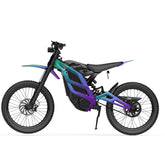The Evolution of Electric Scooters: From Concept to Commuter
The Evolution of Electric Scooters: From Concept to Commuter
Introduction
Electric scooters have transformed from a niche invention to a mainstream mode of urban transportation. Initially seen as a novelty, they are now widely used by commuters worldwide, offering an efficient, affordable, and environmentally friendly solution for short-distance travel. With advancements in technology and changing urban mobility needs, electric scooters (or e-scooters) have carved out a significant role in the transportation ecosystem.
In this article, we'll explore the journey of electric scooters from their conceptual origins to becoming an integral part of modern commuting. We’ll dive into technological advancements, regulatory landscapes, environmental impacts, and future trends that shape the industry.
The Early Days: The Birth of Electric Scooters
The concept of electric-powered transportation dates back over a century, with early experiments in battery-powered vehicles. However, the first electric scooters were developed in the late 20th century. Early prototypes were bulky, inefficient, and had limited battery life, making them impractical for widespread use.
Some of the earliest models were introduced in the 1990s, but they lacked the efficiency and durability needed for everyday commuting. The primary challenges included:
- Limited battery capacity: Early batteries were heavy and had a short lifespan.
- Lack of infrastructure: No dedicated lanes or charging stations existed.
- High costs: Production costs were too high for mass-market adoption.
Despite these limitations, the concept of electric scooters persisted, paving the way for technological advancements that would later revolutionize the industry.
Technological Advancements in Electric Scooters
The last two decades have seen major improvements in electric scooter technology, making them more reliable and accessible. The key advancements include:
1. Battery Technology
- The shift from lead-acid to lithium-ion batteries significantly improved battery life and charging times.
- Modern e-scooters can now travel 30–50 miles on a single charge compared to early models that struggled to reach 10 miles.
- Fast-charging capabilities have reduced downtime, making e-scooters more practical for daily use.
2. Motor Efficiency
- Brushless DC motors have enhanced performance while maintaining energy efficiency.
- Newer models have higher torque and smoother acceleration, making them safer and easier to ride.
3. Smart Features
- Integration with smartphone apps allows users to track battery levels, GPS navigation, and anti-theft protection.
- Some models now feature AI-powered safety alerts and collision detection systems.
These innovations have made electric scooters a viable option for urban mobility, fueling their rapid growth in popularity.
The Rise of E-Scooters in Urban Mobility
As cities become more congested, electric scooters offer a practical solution for short-distance commuting. Their rise can be attributed to several factors:
- Affordability: Unlike cars, electric scooters require minimal maintenance and operational costs.
- Convenience: They provide an easy way to navigate through traffic, especially in dense urban areas.
- Eco-friendliness: They produce zero emissions, making them an environmentally sustainable alternative to gas-powered vehicles.
Many urban centers now have dedicated e-scooter-sharing programs, allowing users to rent and ride scooters through mobile apps. Companies like Bird, Lime, and Spin have expanded their fleets across major cities worldwide.
However, this rapid adoption has also raised challenges, including pedestrian safety concerns, improper parking, and the need for proper regulations.
The Role of Government Regulations and Policies
With the growing popularity of electric scooters, governments have had to introduce regulations to ensure safety and order in public spaces. Key aspects of regulation include:
- Speed limits: Many cities cap scooter speeds at 15–20 mph to prevent accidents.
- Helmet laws: Some regions require riders to wear helmets, especially for younger users.
- Parking regulations: To prevent clutter on sidewalks, designated parking zones have been introduced.
Additionally, some governments offer incentives for e-scooter adoption, such as tax breaks and subsidies for environmentally friendly transportation. However, inconsistent regulations across different locations remain a challenge for global e-scooter companies.
The Impact of Electric Scooters on the Environment
One of the biggest selling points of electric scooters is their environmental benefits. With growing concerns over climate change and pollution, e-scooters offer a sustainable alternative to traditional gas-powered vehicles.
1. Reduced Carbon Footprint
Electric scooters produce zero direct emissions, which means they do not contribute to air pollution like cars and motorcycles do. According to research, a single electric scooter emits 94% less CO₂ per mile than an average car, making them a greener choice for short commutes.
2. Energy Efficiency
Compared to other modes of transportation, e-scooters require minimal energy. Charging a scooter battery consumes significantly less electricity than charging an electric car or operating public transit. Many companies are also exploring solar-powered charging stations to further reduce their environmental impact.
3. Sustainable Manufacturing and Recycling
Manufacturers are now focusing on:
- Using recycled materials in scooter production.
- Designing longer-lasting batteries to reduce e-waste.
- Implementing battery recycling programs to safely dispose of old batteries.
However, some critics argue that shared e-scooters have a shorter lifespan due to misuse and vandalism. To counter this, companies are developing more durable frames and better maintenance programs.
Challenges Facing the Electric Scooter Industry
Despite their advantages, electric scooters still face several challenges that hinder their full potential.
1. Infrastructure Issues
Most cities are not designed for electric scooters, leading to problems such as:
- Lack of dedicated lanes, making it unsafe to ride among cars and pedestrians.
- Limited charging stations, causing inconvenience for private scooter owners.
- Inconsistent parking regulations, leading to cluttered sidewalks.
2. Safety Concerns
As e-scooters become more popular, accidents have also increased. Common risks include:
- Riders not wearing helmets or proper safety gear.
- Collisions with cars, pedestrians, or obstacles due to high speeds.
- Poor road conditions, such as potholes and uneven pavement, making riding dangerous.
Many cities have introduced safety measures, including mandatory helmet laws, speed restrictions, and public awareness campaigns to educate riders on responsible usage.
3. Vandalism and Theft
Shared e-scooter services often deal with theft and vandalism. Some solutions being tested include:
- GPS tracking to locate lost or stolen scooters.
- Stronger locks and anti-theft features on rental scooters.
- Fines and penalties for users who damage scooters.
While these measures help, there is still room for improvement in making shared e-scooters more secure.
Innovations Shaping the Future of Electric Scooters
The future of electric scooters looks promising, with cutting-edge technology enhancing performance, safety, and user experience. Some upcoming innovations include:
1. AI-Driven Navigation and Autonomous E-Scooters
- Companies are experimenting with self-driving e-scooters that can return to charging stations on their own.
- AI-powered navigation can help riders avoid accidents and find the safest routes.
2. Sustainable Battery Solutions
- Researchers are developing solid-state batteries that offer longer life and faster charging than lithium-ion batteries.
- Some companies are introducing swappable batteries, allowing riders to quickly replace dead batteries instead of waiting for a charge.
3. Smart Safety Features
- Collision detection systems to warn riders of obstacles.
- Automatic braking and stability control for safer rides.
- Built-in cameras and sensors to monitor traffic conditions.
With these innovations, e-scooters are expected to become even more reliable and efficient for everyday commuting.
Comparing Electric Scooters with Other Modes of Transportation
Electric scooters compete with various other transportation methods. Here’s how they compare:
1. E-Scooters vs. Bicycles
| Feature | Electric Scooters | Bicycles |
|---|---|---|
| Speed | Faster (up to 20 mph) | Slower unless electric |
| Effort | No pedaling required | Requires physical effort |
| Cost | Higher upfront cost | Cheaper overall |
| Environmental Impact | Low emissions | Zero emissions |
2. E-Scooters vs. Public Transport
| Feature | Electric Scooters | Public Transport |
|---|---|---|
| Flexibility | Go anywhere, anytime | Fixed schedules and routes |
| Cost | One-time purchase or rental | Regular fare costs |
| Comfort | Personal and independent | Crowded at peak hours |
3. E-Scooters vs. Cars
| Feature | Electric Scooters | Cars |
|---|---|---|
| Fuel Costs | Almost zero | Expensive fuel required |
| Traffic | Avoids congestion | Stuck in traffic |
| Parking | Easy to park anywhere | Requires parking space |
Overall, electric scooters offer a cost-effective, flexible, and eco-friendly alternative to traditional transport options.
The Future of Electric Scooters: What's Next?
As cities become more congested and environmental awareness grows, the demand for electric scooters is set to rise. Key predictions for the future include:
- Global Expansion: More cities worldwide will integrate e-scooters into their transportation networks.
- Smarter Infrastructure: Governments will develop dedicated lanes, charging stations, and parking solutions.
- Better Sustainability: Advances in battery technology will reduce environmental impact and improve longevity.
- Multimodal Integration: E-scooters will seamlessly integrate with buses, trains, and ride-sharing services for a connected urban transport system.
In the coming years, electric scooters will likely play an even bigger role in redefining urban mobility, making cities cleaner, quieter, and more efficient.
Conclusion
Electric scooters have come a long way from being just a concept to becoming an essential mode of transport in urban areas. Their rise is fueled by technological advancements, eco-friendly benefits, and increasing demand for convenient transportation. However, challenges such as safety concerns, regulatory issues, and infrastructure limitations must still be addressed.
With continuous innovation and supportive government policies, electric scooters have the potential to revolutionize the way people commute, offering a sustainable and practical solution for the future of transportation.
FAQs
1. Are electric scooters a reliable mode of transportation?
Yes! Electric scooters are reliable for short to medium-distance commutes, offering convenience, affordability, and eco-friendliness. However, reliability depends on battery life, road conditions, and maintenance.
2. How long does an electric scooter battery last?
Most modern electric scooters can run between 20 to 50 miles per charge, depending on battery capacity, speed, and terrain. Batteries typically last 2 to 4 years before needing replacement.
3. Are electric scooters legal everywhere?
Laws vary by country and city. Some places allow e-scooters on roads and bike lanes, while others have restrictions. Always check local regulations before riding.
4. How do electric scooters impact traffic congestion?
E-scooters help reduce congestion by taking cars off the road, especially for short-distance trips. They also provide an alternative to crowded public transport.
5. What are the main maintenance requirements for electric scooters?
Regular maintenance includes checking the battery, brakes, and tires, keeping the scooter clean, and ensuring software updates for smart features. Proper care extends the lifespan of the scooter.










